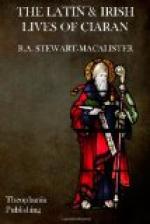The mutual blessings of the two saints may be compared with the prophecy said to have been uttered by Ciaran of Saints Cronan and Molan who visited him at Clonmacnois (CS, 542). The one (Cronan) took away with him the remains of his repast for distribution to the poor, the other left them behind in the monastery; whereupon Ciaran said that the monastery of the one should be rich in wealth and in charity, that of the other should always maintain the rule (of poverty). Such tales as this, of compacts between saints, are probably based on mutual arrangements of one kind or another between the monasteries which claimed the saints as founders; we have already seen leagues established between Clonard and Aran on one side and Clonmacnois on the other, expressed as leagues made by Ciaran with Findian and Enda respectively. Contrariwise, we read of the disagreement of saints when their monasteries were at feud with one another. Ciaran was not always so successful in making treaties with his ecclesiastical brethren. Thus, he is said to have made overtures to Colman mac Luachain of Lann (now Lynn, Co. Westmeath)—a remarkable feat in itself, as Colman died about a century after his time—but not only did Colman refuse, but he sent a swarm of demons in the shape of wasps to repel Ciaran and his followers, who were journeying towards him. Ciaran then made a more moderate offer, which Colman again refused.[26] Lann was in the territory of the Delbna, who, although friendly to Clonmacnois in the middle of the eleventh century, plundered it towards its close (Chronicon Scotorum, 1058, 1090; Annals of Four Masters, 1060).
The chronology of Ciaran the Elder is entirely uncertain. He is said to have been one of the pre-Patrician saints, in which case he could hardly have been a contemporary of Ciaran the Younger, unless we believe in the portentous length of life with which the hagiographers credit him (over three centuries, according to the Martyrology of Donegal, though others are content with a more moderate estimate).
The story of Crithir is told again in the Lives of Ciaran the Elder (see Silua Gadelica, vol. i, p. 14, and corresponding translation). The culprit is there called Crithid, and the version adds that the event took place in a time of snow.
The Geographical Names in LA.—Saigyr, properly Saigir, is now Seir-Kieran in King’s Co. Hele, properly Eile, was a region comprising the baronies of Clonlisk and Ballybrit in King’s Co., and Eliogarty and Ikerrin in Tipperary.
XLVI. HOW AN INSULT TO CIARAN WAS AVERTED (LB)
For parallels to this story see Plummer, VSH, i, p. clxxxvii, note. Compare also the third of the metrical fragments with which LB closes. It is clear that the purpose of the robbers was to efface the tonsure of the saint; very likely ecclesiastics were on occasion subjected to such rough treatment during the period of transition between Paganism and Christianity.




